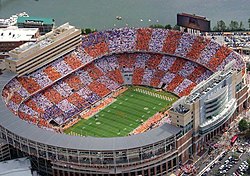
Back Neyland Stadium German Neyland Stadium Spanish ورزشگاه نیلند Persian Neyland Stadium French ニーランド・スタジアム Japanese Neyland Stadium Polish Neyland Stadium Portuguese 尼蘭體育場 Chinese
 Aerial photograph of Neyland Stadium | |
 | |
| Former names | Shields–Watkins Field (1921–Present) |
|---|---|
| Address | 1235 Phillip Fulmer Way Knoxville, TN USA |
| Location | Knoxville, Tennessee |
| Coordinates | 35°57′18″N 83°55′30″W / 35.9550°N 83.9250°W |
| Owner | University of Tennessee |
| Operator | University of Tennessee |
| Capacity | 101,915 (since 2022)[2] |
| Record attendance | 109,061, on September 18, 2004, vs. Florida |
| Surface | Grass (1921–1967, 1994–present) Artificial turf (1968–1993) |
| Construction | |
| Broke ground | March 21, 1921[1] |
| Opened | September 24, 1921 |
| Renovated | 2006, 2008, 2010, 2022 |
| Expanded | 1926, 1929, 1937–1938, 1948, 1962, 1966, 1968, 1972, 1976, 1980, 1987, 1990, 1996 |
| Construction cost | $42,000 ($575,000 in 2021) $136.4 million (2004–2010 renovations) |
| Architect | McCarty Holsaple McCarty (renovations) |
| Tenants | |
| Tennessee Volunteers football (NCAA) (1921–present) | |
| Website | |
| utsports.com/neylandstadium | |
Neyland Stadium (/ˈniːlənd/ NEE-lənd)[3] is a sports stadium in Knoxville, Tennessee, United States. It serves primarily as the home of the Tennessee Volunteers football team, but is also used to host large conventions and has been a site for several National Football League (NFL) exhibition games. The stadium's official capacity is 101,915.[4] Constructed in 1921 as Shields–Watkins Field (which is now the name of the playing surface), the stadium has undergone 16 expansion projects,[5] at one point reaching a capacity of 104,079 before being slightly reduced by alterations in the following decade. Neyland Stadium is the sixth largest stadium in the United States,[6] the eighth largest stadium in the world, and the third largest stadium in the Southeastern Conference. The stadium is named for Robert Neyland, who served three stints as head football coach at the University of Tennessee between 1926 and 1952.
- ^ Mattingly, Tom. "Mattingly: Stadium once 'forlorn sight'". GoVolsXtra. Retrieved September 1, 2012.
- ^ "Neyland Stadium". Tennessee Volunteers Athletics. Archived from the original on July 28, 2011. Retrieved July 8, 2010.
- ^ ""KNEE-land, LIKE MY KNEE" | the Vol Historian | GoVolsXtra.com". Archived from the original on June 11, 2013. Retrieved December 16, 2011.
- ^ Cite error: The named reference
phase3was invoked but never defined (see the help page). - ^ "University of Tennessee Neyland Stadium". Design & Build With Metal.com. Retrieved August 14, 2021.
- ^ Neyland Stadium / Shields-Watkins Field Archived November 21, 2011, at the Wayback Machine, Volmanac, 2011. Retrieved: September 6, 2011.